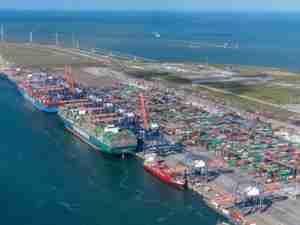"Our customers and business partners have worked with Port staff and our clean air authorities to develop comprehensive and market-led approaches to environmental stewardship," said Port of Tacoma Commission President Clare Petrich. "Their decisions to voluntarily participate in these efforts are voluntary and they come at a cost. But they recognize that today that environmental stewardship makes good sense and is good business."
By special resolution, the Commission recognized Tacoma ocean carrier customers Evergreen, "K" Line, Maersk Line and Horizon Lines for voluntarily switching to cleaner-burning low-sulfur distillate fuel at berth. Use of the cleaner fuel reduces sulfur dioxide emissions up to 80 percent and cuts diesel particulates up to 70 percent.
"We appreciate our customers' partnership in making our Port a cleaner, safer place to work," said Sue Mauermann, the Port's Director of Environmental Programs.
Reducing diesel emissions from ocean-going vessels is a key component of the Northwest Ports Clean Air Strategy, adopted in 2007 by the Port of Tacoma, Port of Seattle and Port Metro Vancouver (Canada). The strategy sets performance goals to reduce diesel emissions and greenhouse gases from ships, rail, cargo-handling equipment, harbor craft and trucks.
A critical component of regional freight transportation, heavy-duty trucks represent one percent of maritime industry diesel emissions at the Port of Tacoma. To reduce this impact, the Port Commission recently authorized a market-based program to reduce over-the-road emissions.
The Port of Tacoma Truck Emissions Improvement Program is designed to improve air quality, increase gate efficiency and be environmentally sustainable. The program, which is fee-free, was developed collaboratively with the trucking industry and other Port customers.
According to a 2008 Port of Tacoma truck fleet study, 86 percent of the heavy-duty drayage trucks serving the Port meet the 2010 emission standards. To encourage the remaining 14 percent to modernize their vehicles, the plan calls for the Port to:
- Develop a list of pre-qualified drayage trucking companies. The Port will promote companies that meet set fleet modernization goals.
- Partner with public and private organizations to identify funding opportunities and options for fleet modernization.
- Work with customers to improve terminal gate operations. This may include enhancing operational efficiency, implementing anti-idling policies and practices, encouraging gate congestion management initiatives, and more.
- Develop a communication and outreach strategy for the regional trucking community. This effort may include a new website that allows truck operators to find specific information, such as turn times at terminals and vessel arrivals.
- Explore operational and technological innovations that might improve efficiency, such as tracking technologies, a chassis pool or secure, pre-gate parking.
- Establish a transparent and accountable system to track the progress of the program toward meeting 2010 and 2015 truck emission goals.
- Continue partnering with the Port of Seattle to implement common components of each port's truck program and coordinate efforts to expedite transportation infrastructure improvements.
People who spoke in favor of the program included representatives of the Washington Trucking Association, Puget Sound Clean Air Agency, Washington Department of Ecology, Washington Retail Association, Washington Department of Transportation and the Port of Seattle.










